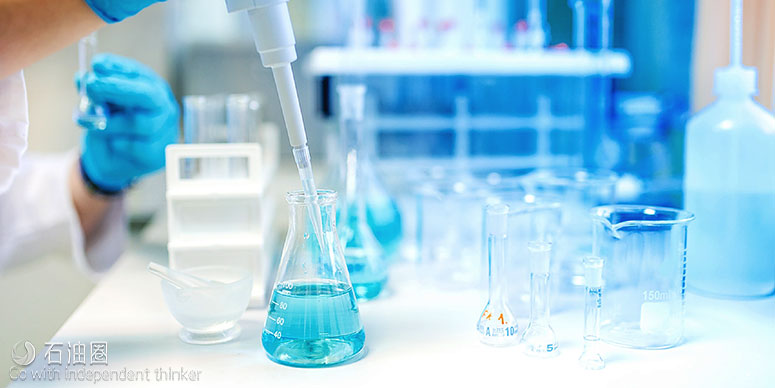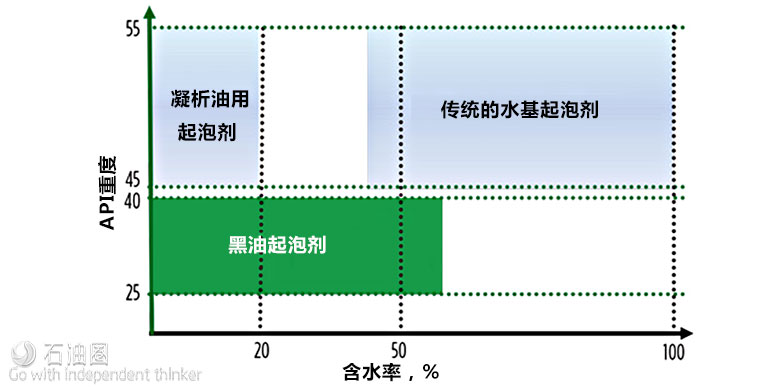A number of technologies are available to bring liquids to surface, thus reducing hydrostatic pressure and keeping production flowing at economical rates. Commonly used deliquification technologies include artificial lift systems, such as gas/plunger lifts and electrical submersible pumps (ESP). These are all effective, but capital-intensive solutions.
Surfactant-based foamers offer a cost-effective treatment alternative to artificial lift as a means of de-liquefying wells. Foamers help remove liquid from a well by reducing the minimum velocity required to unload the liquid, known commonly as the gas critical velocity. The magnitude of this velocity is impacted by two major physical properties of the liquid—its density and its surface tension. By reducing both liquid surface tension and density, foamers subsequently reduce critical velocity.
Foamers have been used for many years to successfully treat onshore gas wells. For example, the application of traditional aqueous foamers to unload brine-rich fluids from gas wells is a well-established practice. In addition, foamers have been developed and applied successfully to unload gas wells rich in condensate, and with API gravities ranging from 45° to 55°.
However, the ability to effectively and economically treat low-API-gravity oil wells has remained a challenge. Traditional foamers typically cannot form foam from black crude oils, and instead tend to produce stable oil-in-water emulsions that are very difficult to treat—particularly offshore, where the residence time in processing equipment tends to be quite short.
The shortcomings of traditional foamer chemistries in offshore oil wells prompted Baker Hughes to undertake a development project aimed at formulating a new black oil foamer. This would extend the foamer operating envelope by assisting crude oil unloading, and achieving smoother production profiles in low-pressure offshore wells producing low gravity crudes, Fig. 1.
SCREENING PROCESS
To reliably meet the widest array of field application requirements, the black oil foamer needed to work effectively with a broad range of crude oils. The foamer also would have to be capable of both batch applications and continuous applications via umbilical, capillary or gas lift.
Candidate oil foamer chemistries were screened in a range of laboratory tests designed to understand their foaming properties and chemical stability under a variety of common offshore conditions.
Dynamic foam column tests. A laboratory dynamic foam test column is used to evaluate materials for their potential to foam crude oils and reduce oil density. The column is water-jacketed to heat the oil and simulate foamer application temperatures. In these lab tests, 100 g of fluid are typically added to the column, and methane is purged at the desired flowrate through a glass frit located at the bottom of the column. After the fluid is heated to the desired temperature, the foamer is added to it.
This test column can be used to simulate both batch and continuous treatment. For a batch-application scenario, a desired dosage of the oil foamer is applied to the fluid from the top of the column. To simulate continuous treatment, an insert containing a port with a septa cap is added between the glass frit and the bottom of the column, and the foamer is injected incrementally into the fluid through a needle inserted into the port. The amount of foaming is then measured after each addition.
If the test column fills with foam, it may begin to “unload,” with foamed fluid exiting through a side-arm assembly at the top of the column. This foamed fluid is collected in a bottle, and the weight of the unloaded fluid is measured to evaluate the foamer’s performance in a batch-treatment scenario. A higher percentage of unloaded foamed fluid indicates that the foamer is more effective in that fluid.
To determine the effectiveness of the foamer for a continuous treatment application, in which the objective is to reduce the density but not necessarily unload fluid, the volume expansion is measured as a function of foamer dosage. Higher volume expansion is correlated with increased foamer effectiveness.
Subsea qualification testing. For onshore continuous injection applications, foamers are typically deployed into the well via a capillary string. But for subsea wells, deployment is complicated, because the foamer must be injected through a miles-long umbilical at the seafloor, where ambient temperatures are just a few degrees above freezing. These conditions introduce additional challenges related to product stability and compatibility, and raise the possibility of umbilical plugging that leads to: increased HSE and operational risks; delays/downtime; costly repair and replacement; and deferred production.
To determine a product’s suitability for subsea injection under these conditions, the service provider uses its FATHOM XT deepwater subsea certification program—a rigorous design, testing, and screening process to confirm reliability, deliverability, and system compatibility. During the validation process, a series of 16 tests is performed to evaluate each product’s performance within these three major criteria:
1.Reliability tests are performed to gauge a product’s stability and ability to withstand sedimentation, phase separation, and haze development. Specific tests include low- and high-temperature stability, stability under temperature cycling conditions, high-pressure umbilical, high-temperature capillary, and long-term “shelf” stability under storage and transportation conditions.
2.Deliverability tests are aimed at achieving a sufficient injection rate in long, small-bore umbilical tubes. These tests examine physical and chemical properties, including hydrate formation susceptibility, pour point, general viscosity, high-pressure viscosity, and density.
3.System compatibility analysis ensures that the product is compatible with standard metals and soft goods used in the construction of the chemical injection and delivery system. Tests include electrochemical pitting susceptibility, metals compatibility, non-metals compatibility, fluid-fluid compatibility, and vapor pressure.
After a product has been qualified for subsea applications through the process, specific manufacturing protocols are followed. These include quality control checks for all raw materials, intermediates, and the final product. A product-specific filtration procedure also is followed, to ensure that the product is contaminant-free and meets required cleanliness specifications prior to injection down the umbilical.

 石油圈
石油圈

